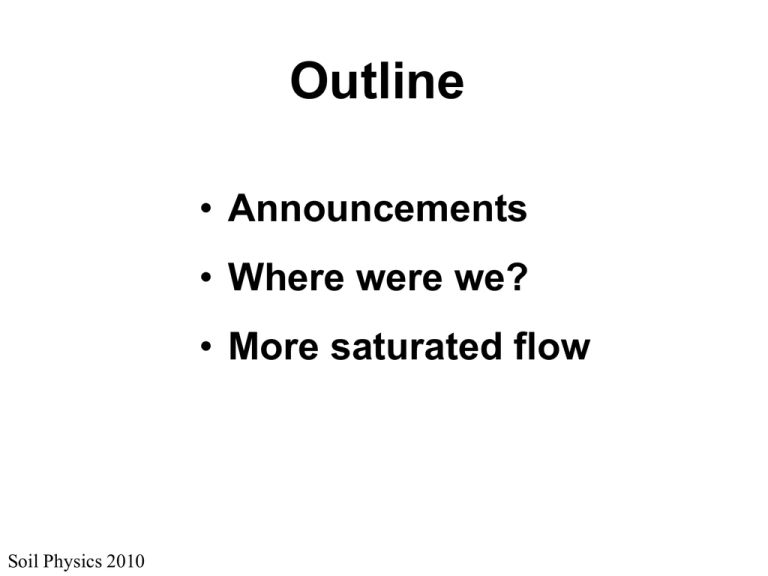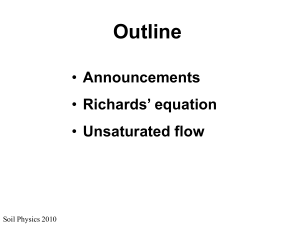saturated flow - Soil Physics, Iowa State University
advertisement

Outline • Announcements • Where were we? • More saturated flow Soil Physics 2010 Announcements • Homework is due now. If all homeworks are handed in now, I will post my answers right after class • Reminder: Exam Friday • Example exam is posted. Soil Physics 2010 Where were we? Q KA Water pressure h1 z1 h 2 L Cross-sectional area of flow Water volume / unit time Soil Physics 2010 Length of flow Proportionality coefficient: Hydraulic conductivity Height z2 Pressure = Elevation? When you swim underwater, your ears feel pressure Depth Why doesn’t the water at the bottom of the pool – under lots of pressure – shoot up to the top? Soil Physics 2010 The water’s potential energy is the same all through the pool. Surface water has elevation; deep water has pressure. Pressure + Elevation Potential Energy Units in Darcy’s Law Q KA 3 L T Soil Physics 2010 L 2 L h L LL T L Velocity Unitless Usually we give the pressure term in units of length, so the gradient is unitless Is this velocity how fast the water moves? 3 L T L 2 L T L L L h Q KA Velocity No. L h L Water flows only through the pores. Water flows through an area Af Water flows at mean velocity u Soil Physics 2010 Q Af K h f L Key implications of Darcy’s law For flow through a uniform medium, the hydraulic gradient is constant. The flow is linearly proportional to the gradient, as in Hooke’s law, Fick’s law, Fourier’s law, etc. K is a property of the medium. Soil Physics 2010 More on Darcy’s law There is no flow without an energy (hydraulic) gradient Components of the gradient: • elevation • pressure • velocity (?) For unit area, use q K Soil Physics 2010 h L What are the units of q? More on Darcy’s law The energy gradient has 3 components: Elevation: potential energy Pressure: “virtual” elevation Velocity: Soil Physics 2010 kinetic energy z p/rg v2/2g Total potential energy The potential energy of water can be expressed several different ways: Basis symbol units energy per unit mass: y J kg-1 energy per unit volume p N m-2 = Pa energy per unit weight h m H2O It is convenient to think of the energy in terms of h Soil Physics 2010 y = p / rw h = p / rw g = y / g Darcy in layered systems Steady-state flow Unit gradient overall K1= 0.2 cm/s Atmosperic pressure at top & bottom K2= 0.1 cm/s L1 = L2 h1 = ? h2 = ? q K Soil Physics 2010 h L q1 = ? q2 = ? Darcy in layered systems q1 q 2 h1 K1= 0.2 cm/s K2= 0.1 cm/s h2 K1 K2 L2 L1 L1 = L2 L1 = L2, so K 1 h1 K 2 h 2 Continuity requires greater gradient for smaller K Soil Physics 2010 Darcy in layered systems K 1 h1 K 2 h 2 0 . 2 h1 0 . 1 h 2 K1= 0.2 cm/s K2= 0.1 cm/s h1 1 h1 2 3 3 L1 L2 L1 L2 h1 h 2 L1 L 2 Soil Physics 2010 Darcy in artificial systems: Given this system, with steady-state water flow, what are the values of the head components at each point? 40cm 20cm C B D A 60cm E Soil Physics 2010 Darcy in artificial systems: We know: pressure p = 0 at points A and E 40cm 20cm C B Elevations can be read from the diagram D A 60cm E elevation + pressure total head (energy) Steady-state flow → q is the same everywhere → linear energy gradient Soil Physics 2010 Darcy in artificial systems: Construct a table: 40cm 20cm C B Elevation + pressure = Total A D 0 B A 60cm E C D E 0 Pressure = 0 at A and E Soil Physics 2010 Darcy in artificial systems: Elevation + pressure = Total 40cm 20cm C B D A 60cm E A 40 B 60 C 60 D 60 E 0 0 0 Take E as reference height Soil Physics 2010 Darcy in artificial systems: Elevation + pressure = Total 40cm 20cm C B D A 60cm E A 40 B 60 C 60 D 60 E 0 0 40 0 0 Elevation + pressure = Total Soil Physics 2010 Darcy in artificial systems: Elevation + pressure = Total 40cm 20cm C B D A 60cm E A 40 B 60 33.3 C 60 26.6 D 60 20 E 0 0 0 40 0 Uniform medium: linear drop in head with distance so at 1/6 of L, we’ve used 1/6 of h Soil Physics 2010 L=120 cm h = 40cm 5/6 * 40 = 33.3 Darcy in artificial systems: Elevation + pressure = Total 40cm 20cm C B D A 60cm E A 40 0 40 B 60 -26.7 33.3 C 60 -33.3 26.7 D 60 -40 20 E 0 0 0 Fill in the rest by difference Soil Physics 2010 Darcy in artificial systems: Summary: 40cm 20cm C B D 60cm • You can use the pieces you know to assemble the whole puzzle. E • Every piece of information is needed: data and theory. A Soil Physics 2010






